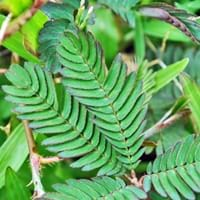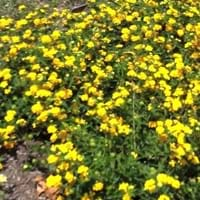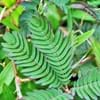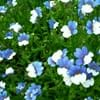Life Span
Perennial
Perennial
Type
Tender Perennial
Tender Perennial
Origin
Brazil
South America, Argentina, Brazil, Chile
Types
Not Available
big-sage, big-sage,white-sage
Habitat
Cropland, Forests, Pastures
open Woodlands, Semi arid regions, Subtropical climates
USDA Hardiness Zone
11-15
8-15
AHS Heat Zone
Not Available
12-4
Sunset Zone
H1, H2
H1, H2, 6, 7, 8, 9, 10, 11, 12, 13, 14, 15, 16, 17, 18, 19, 20, 21, 22, 23, 24
Habit
Spreading
Oval or Rounded
Minimum Height
Not Available
Minimum Width
Not Available
Flower Color
Pink, Rose, Lavender
Gold
Flower Color Modifier
Bicolor
Bicolor
Fruit Color
Brown
Blue, Black
Leaf Color in Spring
Green, Gray Green
Dark Green
Leaf Color in Summer
Green, Gray Green
Dark Green
Leaf Color in Fall
Green, Gray Green
Dark Green
Leaf Color in Winter
Light Green
Light Green
Leaf Shape
Pinnate
Oval with toothed margin
Plant Season
Spring, Summer, Fall, Winter
Spring, Summer, Fall, Winter
Sunlight
Full Sun, Partial Sun, Partial shade
Full Sun, Partial Sun
Type of Soil
Loam
Clay, Loam, Sand
The pH of Soil
Neutral
Acidic, Neutral, Alkaline
Soil Drainage
Well drained
Average
Bloom Time
Early Summer, Summer, Late Summer
Indeterminate
Tolerances
Drought
Drought
Where to Plant?
Ground, Pot
Container, Ground
How to Plant?
Seedlings
Stem Cutting
Plant Maintenance
Medium
Medium
Watering Requirements
Requires regular watering
Does not require regular watering
In Summer
Lots of watering
Lots of watering
In Spring
Moderate
Moderate
In Winter
Average Water
Average Water
Soil pH
Neutral
Acidic, Neutral, Alkaline
Soil Type
Loam
Clay, Loam, Sand
Soil Drainage Capacity
Well drained
Average
Sun Exposure
Full Sun, Partial Sun, Partial shade
Full Sun, Partial Sun
Pruning
Remove damaged leaves, Remove dead branches, Remove dead leaves
Remove damaged leaves, Remove dead branches, Remove dead leaves
Fertilizers
All-Purpose Liquid Fertilizer
All-Purpose Liquid Fertilizer
Pests and Diseases
bees, Wasps
Red blotch, Whiteflies
Plant Tolerance
Drought
Drought
Flower Petal Number
Single
Single
Fragrant Bark/Stem
No
Yes
Foliage Texture
Fine
Medium
Foliage Sheen
Matte
Matte
Attracts
Insects
Butterflies
Allergy
allergic conjunctivitis, Hay fever
Skin irritation
Aesthetic Uses
Beautification, Showy Purposes
Not Available
Beauty Benefits
Not Available
Not Available
Environmental Uses
Air purification
Air purification
Medicinal Uses
Antivinous, Diarrhea, Fertility, Piles, Stomach Ulcers
anti-cancer, Antirheumatic, Antiulcerogenic, Malaria
Part of Plant Used
Leaves, Root
Leaves
Other Uses
Used for its medicinal properties
Showy Purposes
Used As Indoor Plant
Yes
Yes
Used As Outdoor Plant
Yes
Yes
Garden Design
Container, Groundcover, Hanging Basket, Mixed Border, Tropical
Bedding Plant, Container, Feature Plant, Foundation, Hanging Basket, Mixed Border, Topiary / Bonsai / Espalier, Tropical
Botanical Name
MIMOSA pudica
LANTANA camara 'New Gold'
Common Name
Action Plant, Sensitive Plant, Touch-Me-Not
Lantana, New Gold Lantana
In Hindi
छुई मुई
new gold lantana
In German
Berühre mich nicht
Wandelröschen
In French
Balsamine
Lantana camara
In Spanish
No me toques
Lantana camara
In Greek
Αγγίξτε-me-not
Lantana camara
In Portuguese
Não me toque
Lantana camara
In Polish
Niecierpek
Lantana pospolita
In Latin
Palpate Me, non-
Lantana camara
Phylum
Magnoliophyta
Magnoliophyta
Class
Magnoliopsida
Magnoliopsida
Order
Geraniales
Lamiales
Family
Fabaceae
Verbenaceae
Clade
Angiosperms, Eudicots, Rosids
Angiosperms, Asterids, Eudicots
Tribe
Not Available
Not Available
Subfamily
Not Available
Not Available
Number of Species
Not Available
Season and Care of Touch-me-not and New Gold Lantana
Season and care of Touch-me-not and New Gold Lantana is important to know. While considering everything about Touch-me-not and New Gold Lantana Care, growing season is an essential factor. Touch-me-not season is Spring, Summer, Fall and Winter and New Gold Lantana season is Spring, Summer, Fall and Winter. The type of soil for Touch-me-not is Loam and for New Gold Lantana is Clay, Loam, Sand while the PH of soil for Touch-me-not is Neutral and for New Gold Lantana is Acidic, Neutral, Alkaline.
Touch-me-not and New Gold Lantana Physical Information
Touch-me-not and New Gold Lantana physical information is very important for comparison. Touch-me-not height is 30.00 cm and width 40.60 cm whereas New Gold Lantana height is Not Available and width Not Available. The color specification of Touch-me-not and New Gold Lantana are as follows:
Touch-me-not flower color: Pink, Rose and Lavender
Touch-me-not leaf color: Green and Gray Green
New Gold Lantana flower color: Gold
- New Gold Lantana leaf color: Dark Green
Care of Touch-me-not and New Gold Lantana
Care of Touch-me-not and New Gold Lantana include pruning, fertilizers, watering etc. Touch-me-not pruning is done Remove damaged leaves, Remove dead branches and Remove dead leaves and New Gold Lantana pruning is done Remove damaged leaves, Remove dead branches and Remove dead leaves. In summer Touch-me-not needs Lots of watering and in winter, it needs Average Water. Whereas, in summer New Gold Lantana needs Lots of watering and in winter, it needs Average Water.





